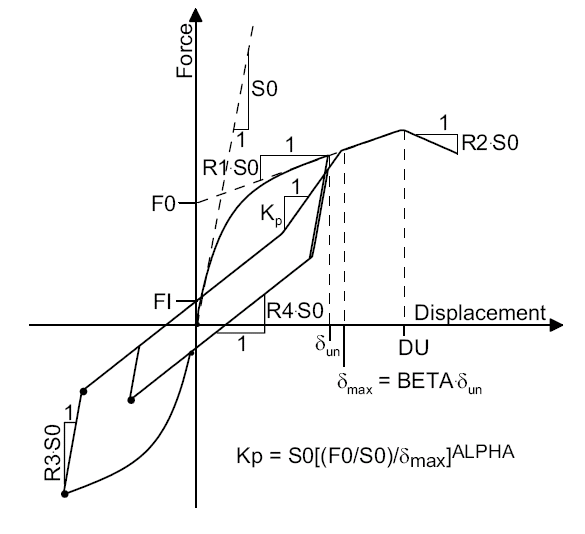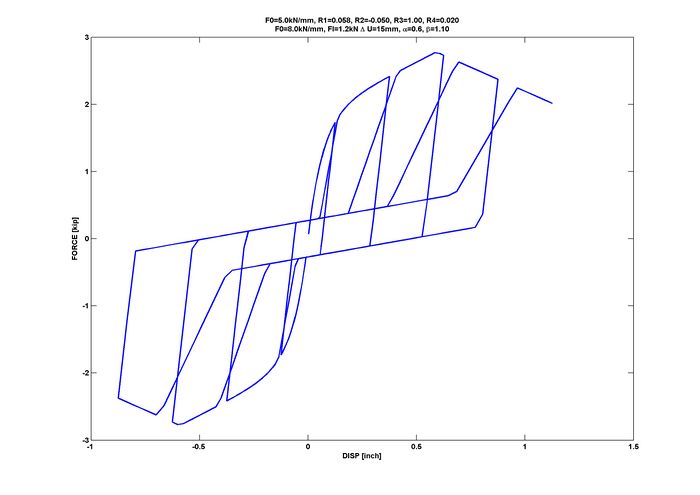SAWS Material: Difference between revisions
(Imported PYSimple1 to start) |
No edit summary |
||
| (6 intermediate revisions by one other user not shown) | |||
| Line 1: | Line 1: | ||
This | {{CommandManualMenu}} | ||
This file contains the class definition for SAWSMaterial. SAWSMaterial provides the implementation of a one-dimensional hysteretic model develeped as part of the CUREe Caltech wood frame project. | |||
{| | {| | ||
| style="background:yellow; color:black; width:800px" | '''uniaxialMaterial | | style="background:yellow; color:black; width:800px" | '''uniaxialMaterial SAWS $tag $F0 $FI $DU $S0 $R1 $R2 $R3 $R4 $alph $beta''' | ||
|} | |} | ||
| Line 11: | Line 13: | ||
| style="width:150px" | '''$matTag ''' || integer tag identifying material | | style="width:150px" | '''$matTag ''' || integer tag identifying material | ||
|- | |- | ||
| '''$ | | '''$F0 ''' || Intercept strength of the shear wall spring element for the asymtotic line to the envelope curve F0 > FI > 0 | ||
|- | |||
| '''$FI ''' || Intercept strength of the spring element for the pinching branch of the hysteretic | |||
curve. (FI > 0). | |||
|- | |||
| '''$DU ''' || Spring element displacement at ultimate load. (DU > 0). | |||
|- | |||
| '''$S0 ''' || Initial stiffness of the shear wall spring element (S0 > 0). | |||
|- | |||
| '''$R1''' || Stiffness ratio of the asymptotic line to the spring element envelope curve. The | |||
slope of this line is R1 S0. (0 < R1 < 1.0). | |||
|- | |||
| '''$R2''' || Stiffness ratio of the descending branch of the spring element envelope curve. The | |||
slope of this line is R2 S0. ( R2 < 0). | |||
|- | |- | ||
| | | '''$R3''' || Stiffness ratio of the unloading branch off the spring element envelope curve. The | ||
slope of this line is R3 S0. ( R3 1). | |||
|- | |- | ||
| | | '''$R4''' || Stiffness ratio of the pinching branch for the spring element. The slope of this line | ||
is R4 S0. ( R4 > 0). | |||
|- | |- | ||
| | | '''$alpha''' || Stiffness degradation parameter for the shear wall spring element. (ALPHA > 0). | ||
|- | |- | ||
| '''$ | | '''$beta''' || Stiffness degradation parameter for the spring element. (BETA > 0). | ||
|} | |} | ||
== Notes: == | |||
Refer to the figure below for more information, and the reference provided at the end of this page for complete details about modeling assumptions. | |||
[[File:FolzFigure.gif]] | |||
== Example Files: == | |||
''Click to download files'' | |||
[[ | [[Media:Test.tcl]] | ||
[[Media:SAWSZeroLength.tcl]] | |||
[[ | == Example: Hysteresis == | ||
[[File:TestHysteresis.jpg|700px]] | |||
== References == | |||
Reference: Folz, B. and Filiatrault, A. (2001). "SAWS - Version 1.0, A Computer Program for the Seismic Analysis of Woodframe Structures", Structural Systems Research Project Report No. SSRP-2001/09, Dept. of Structural Engineering, UCSD, La Jolla, CA . | |||
---- | ---- | ||
Code Developed by: <span style="color:blue"> | Code Developed by: <span style="color:blue"> Patxi Uriz, Exponent </span> (Converted from FORTRAN code originally written by Bryan Folz) | ||
Latest revision as of 21:13, 3 March 2010
- Command_Manual
- Tcl Commands
- Modeling_Commands
- model
- uniaxialMaterial
- ndMaterial
- frictionModel
- section
- geometricTransf
- element
- node
- sp commands
- mp commands
- timeSeries
- pattern
- mass
- block commands
- region
- rayleigh
- Analysis Commands
- Output Commands
- Misc Commands
- DataBase Commands
This file contains the class definition for SAWSMaterial. SAWSMaterial provides the implementation of a one-dimensional hysteretic model develeped as part of the CUREe Caltech wood frame project.
| uniaxialMaterial SAWS $tag $F0 $FI $DU $S0 $R1 $R2 $R3 $R4 $alph $beta |
| $matTag | integer tag identifying material |
| $F0 | Intercept strength of the shear wall spring element for the asymtotic line to the envelope curve F0 > FI > 0 |
| $FI | Intercept strength of the spring element for the pinching branch of the hysteretic
curve. (FI > 0). |
| $DU | Spring element displacement at ultimate load. (DU > 0). |
| $S0 | Initial stiffness of the shear wall spring element (S0 > 0). |
| $R1 | Stiffness ratio of the asymptotic line to the spring element envelope curve. The
slope of this line is R1 S0. (0 < R1 < 1.0). |
| $R2 | Stiffness ratio of the descending branch of the spring element envelope curve. The
slope of this line is R2 S0. ( R2 < 0). |
| $R3 | Stiffness ratio of the unloading branch off the spring element envelope curve. The
slope of this line is R3 S0. ( R3 1). |
| $R4 | Stiffness ratio of the pinching branch for the spring element. The slope of this line
is R4 S0. ( R4 > 0). |
| $alpha | Stiffness degradation parameter for the shear wall spring element. (ALPHA > 0). |
| $beta | Stiffness degradation parameter for the spring element. (BETA > 0). |
Notes:
Refer to the figure below for more information, and the reference provided at the end of this page for complete details about modeling assumptions.
Example Files:
Click to download files
Example: Hysteresis
References
Reference: Folz, B. and Filiatrault, A. (2001). "SAWS - Version 1.0, A Computer Program for the Seismic Analysis of Woodframe Structures", Structural Systems Research Project Report No. SSRP-2001/09, Dept. of Structural Engineering, UCSD, La Jolla, CA .
Code Developed by: Patxi Uriz, Exponent (Converted from FORTRAN code originally written by Bryan Folz)

